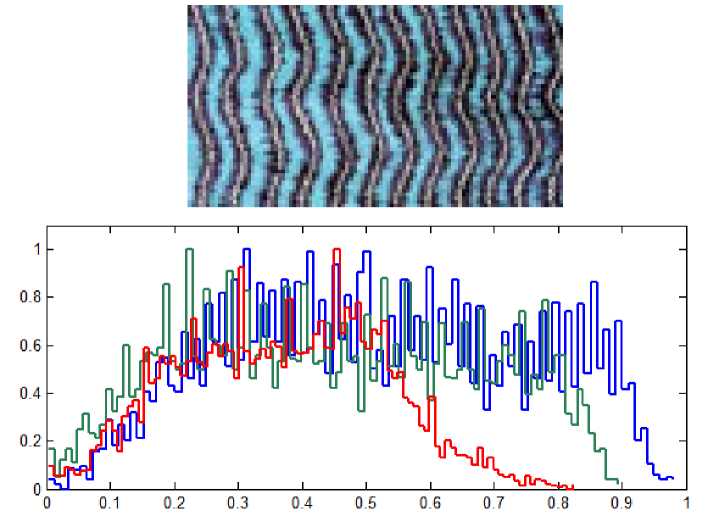M motif = mdim ∪ mcolor (4)
where we could define the red, green, and blue is the dominant elements from each color vectors,
mcooor = max [ Hrgb ( w )] (5)
that is also the average or most frequent elements from the respective colorization vectors.
Sasirangan Motif (South Kalimantan)

Figure 2
The Red-Green-Blue histogram of Sasirangan (South Kalimantan) motif
The expression (5) reflects the elementary information related to the colorization of the decorations
and ornamentations of the artifacts we would like to observe. These two features constitute the
memeplexes that are reflecting the cultural objects which is in the form of digital images. Our data
sets are taken from various resources and references, from the books of textiles [4, 5, 12] to the
direct observation to the centers of the craftsman. That is why, when it is related to the analytical
models of colorization, the histogram equalization becomes a very relevant issue.
From the variables obtained in the two computational observations and calculations we can fill the
memeplexes emanating from each artifact. The method of the phylomemetic tree construction is
based upon the correlations transformed into distances in ultrametric spaces among memeplexes as
it has been discussed in [10]. Here, we can outline two sets of data, one related to the complexity of
batik and another several samples of Indonesian general textiles. The first is interesting since batik
has been widely recognized even in international stages as signature of Indonesian fashion. Batik
depicts the complexity related to not only the processes of ornamentation and the related usages in
(Javanese) specific occasions but also places where the unique batik is crafted: the palace-centric
(keraton) batik and those which produced in creative industries of coastal areas in Java [11].
More intriguing information
1. Competition In or For the Field: Which is Better2. The name is absent
3. Auctions in an outcome-based payment scheme to reward ecological services in agriculture – Conception, implementation and results
4. The name is absent
5. Knowledge and Learning in Complex Urban Renewal Projects; Towards a Process Design
6. The name is absent
7. Stillbirth in a Tertiary Care Referral Hospital in North Bengal - A Review of Causes, Risk Factors and Prevention Strategies
8. The name is absent
9. Long-Term Capital Movements
10. A Multimodal Framework for Computer Mediated Learning: The Reshaping of Curriculum Knowledge and Learning